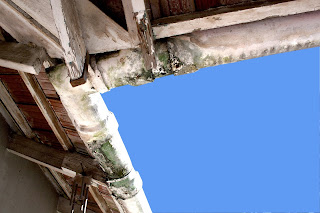The Risk is in Your Home
Asbestos, once known as the miracle fiber due to is fire retardant properties, high tensile strength and ability to mix with a wide range of materials, may still be found in millions of homes in South Africa, especially those built in the early 1940s through to the late 1990s.
Over time, the asbestos breaks-up into invisible microscopic fibres that can be inhaled deep into the lungs. Breathing in asbestos fibres can cause serious lung diseases, including asbestosis, incurable lung cancer and mesothelioma. The symptoms of these diseases do not usually appear until about 20 to 30 years after the first exposure to asbestos and are always fatal. Every year hundreds of people are diagnosed with these diseases.
Asbestos was extensively mined in the Northern Cape since the 1930s and was, among others, mixed with cement to manufacture a large variety of building products, including roof tiles, corrugated roof and wall cladding, ceiling boards, flooring, gutters, window sills, water pipes, textured paints, insulation, fireproofing materials, pot plant containers and many more.
Although undisturbed asbestos poses no harm, homeowners need to know the dangers involved when renovating, along with the consequences of exposure to invisible asbestos fibres. When asbestos building products are disturbed during demolition, cut with an angle grinder, sawed, drilled or damaged in any other way, it releases microscopic asbestos fibers that create a serious risk of asbestos exposure, especially in children and infants. There is NO safe level of exposure to asbestos.
If you plan to demolish or remodel part of an older home, you may wish to seek professional advice first. There is no way of telling whether a product contains asbestos by looking at it with the naked eye. Fortunately, laboratory testing for asbestos in building products is an easy procedure and relatively inexpensive.
You Can Test for Asbestos Yourself
You can take a sample yourself and send it to our laboratory for accurate and fast results. All you need is the following items, available from Builders Warehouse.
- Trigger spray bottle.
- Plastic bin liner.
- Protective gloves.
- FFP2 dust mask.
- Tools: Scissors, large pliers or screw driver.
- Ziploc ® Plastic bag.
Sampling Procedure
Follow the procedure outlined below to minimize any risk to you or your family. If unsure, rather call AirCHECK for assistance.
- Lay plastic sheeting below the area where samples will be taken and secure with tape.
- Spray the area to be tested with soapy water to keep loose fibers from getting in the air.
- Use a tool to cut into the substance, or to break off a small piece to be tested. We only need a piece as large as your thumbnail. DO NOT SCRAPE MATERIAL FROM THE SURFACE.
- Place the small sample in a Ziploc ® bag to be sent to the laboratory for testing.
- Seal the surface where the sample was taken with a PVA paint.
- Place protective clothing and plastic bin liner contaminated by the material in a sealed container and dispose of properly.
Samples may be couriered to our laboratory with any commercial door to door service. Please ensure that the sample is properly identified, sealed securely and that your address and contact details are included.
Ship to:
AirCHECK Place
8 Roux Road
Bryanston
South Africa
Need help?
Please contact us on 082 444 8713 or 082 083 4580 or 082 554 6479.
Or email us at admin@aircheck-aia.co.za.


Thank you for sharing the report. Indeed there is still a lot that we need to do to fight cancer not just in Africa, but globally. I feel that we need to engage the your as well. They are the future and can make a difference. Cancer in Africa
ReplyDeleteHi ,
ReplyDeleteAwesome Blog.
Such this post is very informative.
Thanks for sharing with us.
Asbestos Painting | Commercial Painting
This comment has been removed by the author.
ReplyDelete